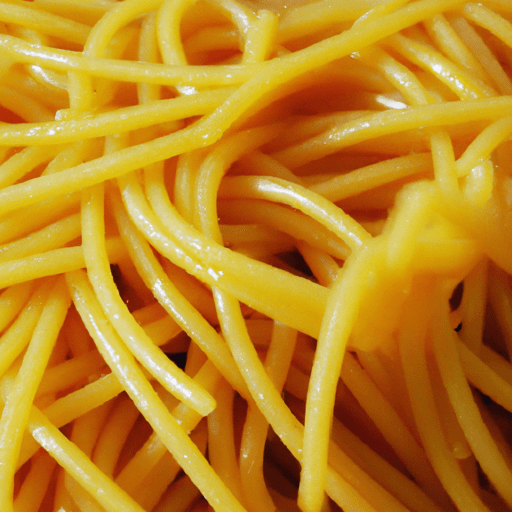Exploring the Delicious World of Bucatini Pasta
If you consider yourself a pasta lover, you simply cannot miss the opportunity to discover bucatini pasta. This traditional Italian specialty stands out with its distinctive appearance and delightful taste. In this blog post, we will delve into the wonderful world of bucatini, exploring its taste, common uses in cooking, nutritional value, and interesting history. So grab your apron and let’s dive in!
Embracing the Taste
Bucatini is a long, tube-shaped pasta that resembles spaghetti at first glance. However, upon closer inspection, you’ll notice that bucatini has a hollow center. This unique shape allows the sauce to cling to and penetrate the entire noodle, resulting in a burst of flavor with every bite.
When cooked al dente, bucatini offers a perfect balance between a tender exterior and a slightly chewy interior. Its smooth texture combined with the subtle nutty flavor make it a true delight for pasta enthusiasts. Bucatini’s wide diameter is perfect for capturing thick and chunky sauces, creating a harmonious and satisfying eating experience.
Versatile in the Kitchen
Bucatini’s versatility in the kitchen makes it a go-to pasta choice for many Italian recipes. This pasta variety pairs wonderfully with a variety of sauces, both simple and complex.
One classic and beloved way to enjoy bucatini is “Bucatini all’Amatriciana.” This Roman dish combines the pasta with a rich tomato sauce, pancetta or guanciale (cured pork cheek), and a generous dose of Pecorino Romano cheese. The combination of salty, savory, and slightly spicy flavors creates a taste explosion that will leave you craving more.
Another popular recipe featuring bucatini is “Spaghetti Carbonara.” In this dish, the hollow pasta tubes perfectly trap the creamy sauce made from eggs, Parmesan cheese, and pancetta or bacon. The result is a velvety, indulgent pasta dish that is sure to please your taste buds.
Nutritional Value
While it’s true that pasta is often associated with carbs, bucatini can still provide valuable nutrients and energy when enjoyed in moderation. Here’s a brief overview of its nutritional profile:
- Carbohydrates: Bucatini is primarily made from durum wheat semolina, contributing to its carbohydrate content. Carbs are an essential macronutrient that provides fuel for our bodies.
- Fiber: The hollow center of bucatini adds a touch of dietary fiber, aiding digestion and promoting a feeling of fullness.
- Protein: While not as protein-rich as some other foods, bucatini contains a moderate amount of protein, which plays a crucial role in building and repairing tissues.
- Iron: This pasta variety contains a small amount of iron, an important nutrient for oxygen transport in the body.
- B Vitamins: Bucatini pasta provides some B vitamins, including thiamine and niacin, which are vital for energy metabolism.
Remember, moderation and balance are key when incorporating bucatini into your diet, especially if you’re mindful of calorie intake.
A Glimpse into Bucatini’s History
Bucatini’s origins can be traced back to the Lazio region of Italy, where it has been enjoyed for centuries. While there is no concrete evidence of its exact inception, it is believed that bucatini was created as a variation of the long, thin spaghetti. As Italian culinary traditions evolved, bucatini gained popularity thanks to its ability to hold up to more robust and complex sauces.
Today, bucatini can be found in Italian specialty food stores worldwide, allowing food enthusiasts all over the globe to experience the satisfaction of this remarkable pasta.
Unlock the Pasta Potential
Whether you’re a pasta enthusiast or simply curious about expanding your culinary horizons, bucatini pasta is a must-try. Its unique shape, pleasant taste, and versatility in the kitchen make it an excellent addition to your recipe repertoire. Remember to explore different sauces and recipes to fully unlock the potential of this delightful pasta.
So, next time you find yourself in love with pasta, consider going beyond the traditional spaghetti and give bucatini a whirl. Your taste buds will thank you!
[Image Source: Unsplash](https://unsplash.com/photos/R6YigK0oaqU)
Bucatini Pasta
- Origin: Bucatini is a type of pasta that originated in central Italy, specifically in the region of Lazio. It is a traditional pasta shape commonly associated with Roman cuisine.
- Shape and Composition: Bucatini is a long and hollow pasta, similar to spaghetti, but thicker and with a hole running through the center. It is made from durum wheat semolina and water, giving it a firm texture when cooked.
- Common Uses: Bucatini is often used in traditional Italian dishes, such as Amatriciana and Cacio e Pepe, where its hollow center allows the sauce to coat both the pasta and the inner tube. It can also be used in soups, salads, or other pasta dishes where its unique shape adds visual interest and texture.
- Nutritional Benefits: Bucatini pasta is primarily made from durum wheat semolina, which provides complex carbohydrates and dietary fiber. It is also a source of iron, B-vitamins, and some minerals. However, the nutritional composition can vary depending on the brand and preparation method.
- Unique Properties: The thick, hollow shape of bucatini sets it apart from other pasta types, allowing sauces to cling both on the exterior and the inside. The hole in the center also adds a unique texture to every bite. The cooking time of bucatini is slightly longer than spaghetti due to its larger diameter.
- Historical Significance: Bucatini has a long history and is believed to have been created during the 14th century. It has been a staple in Italian cuisine for centuries and holds cultural significance, especially in the region of Lazio and Rome. Many traditional recipes have been passed down through generations, preserving the pasta’s historical importance in Italian culinary heritage.




Use the share button below if you liked it.
It makes me smile, when I see it.